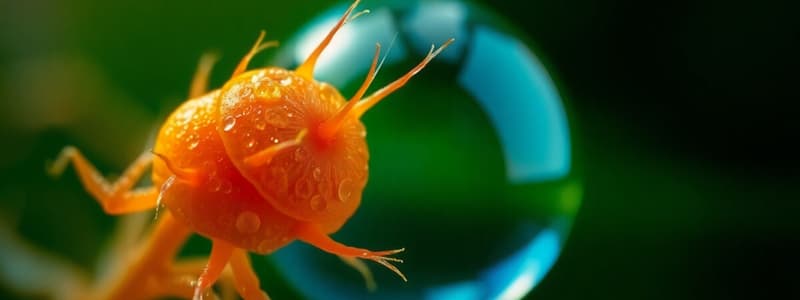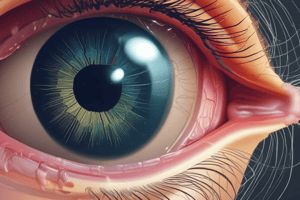Podcast
Questions and Answers
Which method is NOT associated with low-level vision?
Which method is NOT associated with low-level vision?
- Edges
- Image classification (correct)
- Feature extraction
- Photo manipulation
Eyespots have a high acuity for detecting light.
Eyespots have a high acuity for detecting light.
False (B)
What is the role of photoreceptive proteins in simple eyes, such as eyespots?
What is the role of photoreceptive proteins in simple eyes, such as eyespots?
To sense ambient light
Photosensitive cells in _____ represent the first stage of eye evolution.
Photosensitive cells in _____ represent the first stage of eye evolution.
Match the type of vision with its corresponding description:
Match the type of vision with its corresponding description:
Which of the following technologies is NOT mentioned in the context of mid-level vision?
Which of the following technologies is NOT mentioned in the context of mid-level vision?
What is the primary function of complex eyes?
What is the primary function of complex eyes?
What range of wavelengths is considered visible light?
What range of wavelengths is considered visible light?
All objects reflect all wavelengths of light equally.
All objects reflect all wavelengths of light equally.
What type of photoreceptor is peak responsive around 498 nm?
What type of photoreceptor is peak responsive around 498 nm?
The 'color' we perceive is based on the relative activation of the three types of cone cells: short, medium, and _______.
The 'color' we perceive is based on the relative activation of the three types of cone cells: short, medium, and _______.
Match each type of cone cell with its corresponding peak wavelength:
Match each type of cone cell with its corresponding peak wavelength:
What is the primary function of rods in the human eye?
What is the primary function of rods in the human eye?
The fovea contains the highest concentration of rods.
The fovea contains the highest concentration of rods.
How many photoreceptive cells are approximately in the human retina?
How many photoreceptive cells are approximately in the human retina?
The cells in the retina that absorb light and transmit information to the brain are called __________.
The cells in the retina that absorb light and transmit information to the brain are called __________.
Match the following types of photoreceptors with their main characteristics:
Match the following types of photoreceptors with their main characteristics:
Which type of photoreceptor is responsible for most daytime vision?
Which type of photoreceptor is responsible for most daytime vision?
The response time of rods is faster than that of cones.
The response time of rods is faster than that of cones.
What happens to rods in bright light conditions?
What happens to rods in bright light conditions?
Humans have approximately __________ million cones in their retinas.
Humans have approximately __________ million cones in their retinas.
Which type of eye movement is characterized by a constant slow movement?
Which type of eye movement is characterized by a constant slow movement?
All animals with eyes possess a brain.
All animals with eyes possess a brain.
What do M cells primarily transmit information about?
What do M cells primarily transmit information about?
The _________ visual cortex is mainly responsible for edge detection.
The _________ visual cortex is mainly responsible for edge detection.
Match the following visual processing components with their primary functions:
Match the following visual processing components with their primary functions:
Which stream is associated with identification and recognition?
Which stream is associated with identification and recognition?
The dorsal system is faster than the ventral system.
The dorsal system is faster than the ventral system.
What is the function of ganglia in visual processing?
What is the function of ganglia in visual processing?
The ________ visual cortex sends strong feedback back to V1.
The ________ visual cortex sends strong feedback back to V1.
Which type of eye movement consists of tiny vibrations that synchronize between the eyes?
Which type of eye movement consists of tiny vibrations that synchronize between the eyes?
What happens if the dorsal system is damaged?
What happens if the dorsal system is damaged?
Blindsight allows a person to recognize objects they cannot see.
Blindsight allows a person to recognize objects they cannot see.
What percentage of the cerebral cortex is devoted to the visual cortex?
What percentage of the cerebral cortex is devoted to the visual cortex?
The brain uses ________ to infer the 3D shape of moving objects.
The brain uses ________ to infer the 3D shape of moving objects.
Match the following visual processing aspects with their descriptions:
Match the following visual processing aspects with their descriptions:
Which process allows the eye to adjust the lens to make an object clear?
Which process allows the eye to adjust the lens to make an object clear?
Convergence is related to the amount of blur in an object.
Convergence is related to the amount of blur in an object.
What is the role of shading in visual perception?
What is the role of shading in visual perception?
The brain can make some high-level decisions, but we still only have a ________ idea of its components' functions.
The brain can make some high-level decisions, but we still only have a ________ idea of its components' functions.
What kind of processing occurs in the visual cortex?
What kind of processing occurs in the visual cortex?
Flashcards
Eyespots
Eyespots
Simple photosensitive proteins with no surrounding structure, used for detecting light.
Pit Eyes
Pit Eyes
These are photosensitive cells located in pits that block some light, providing rudimentary direction information.
Refraction
Refraction
The process of bending light to focus it on a specific area, allowing for clearer and brighter vision.
Pit Eyes Evolution
Pit Eyes Evolution
Signup and view all the flashcards
Euglena and Eyespots
Euglena and Eyespots
Signup and view all the flashcards
Snails and Eyespots
Snails and Eyespots
Signup and view all the flashcards
Eyespot Limitations
Eyespot Limitations
Signup and view all the flashcards
Lens
Lens
Signup and view all the flashcards
Cones
Cones
Signup and view all the flashcards
Rods
Rods
Signup and view all the flashcards
Fovea
Fovea
Signup and view all the flashcards
Peripheral Vision
Peripheral Vision
Signup and view all the flashcards
Phototransduction
Phototransduction
Signup and view all the flashcards
Optic Nerve
Optic Nerve
Signup and view all the flashcards
Visual Cortex
Visual Cortex
Signup and view all the flashcards
Visual Acuity
Visual Acuity
Signup and view all the flashcards
Visible light range
Visible light range
Signup and view all the flashcards
Object color and reflection
Object color and reflection
Signup and view all the flashcards
Color perception
Color perception
Signup and view all the flashcards
Photoreceptor types
Photoreceptor types
Signup and view all the flashcards
Cone types and sensitivity
Cone types and sensitivity
Signup and view all the flashcards
Fixational Eye Movement
Fixational Eye Movement
Signup and view all the flashcards
Microsaccades
Microsaccades
Signup and view all the flashcards
Ocular Drift
Ocular Drift
Signup and view all the flashcards
Microtremors
Microtremors
Signup and view all the flashcards
Ganglia
Ganglia
Signup and view all the flashcards
M Cells
M Cells
Signup and view all the flashcards
P Cells
P Cells
Signup and view all the flashcards
V1
V1
Signup and view all the flashcards
V2
V2
Signup and view all the flashcards
Motion Parallax
Motion Parallax
Signup and view all the flashcards
Dorsal and Ventral Visual Streams
Dorsal and Ventral Visual Streams
Signup and view all the flashcards
Blindsight
Blindsight
Signup and view all the flashcards
3D Vision
3D Vision
Signup and view all the flashcards
Kinetic Depth
Kinetic Depth
Signup and view all the flashcards
Occlusion
Occlusion
Signup and view all the flashcards
Familiar Size
Familiar Size
Signup and view all the flashcards
Shading
Shading
Signup and view all the flashcards
What We Don't Know About Vision
What We Don't Know About Vision
Signup and view all the flashcards
Study Notes
Computer Vision
- Lecture presented by Dr. Ahmed Taha, Computer Science Department, Faculty of Computers & Artificial Intelligence, Benha University
- Topic covers human vision, low-level vision, mid-level vision and high-level vision.
Human Vision
- Eyes are the sensors for vision
- The brain processes visual information.
Low-Level Vision
- Photo manipulation including size, color and exposure
- Feature extraction including edges and oriented gradients, segments using X-Pro II
- Key aspects of visual processing
Mid-Level Vision
- Image relationships to image and world
- Methods like panoramas, multi-view stereo, structure from motion, structured light and LIDAR (Light Detection and Ranging)
- Connections between images and time using techniques like optical flow and time-lapse
High-Level Vision
- Image classification and relationship to semantics
- Object detection and segmentation
- Applications like retrieval and robotics
Is Vision Easy or Hard for Humans?
- A discussion prompt.
Eyes - The Sensors for Vision
- Eyes are the receptors for visual stimuli.
Why do things have eyes?
- Visual stimulus is an important signal
- Photoreceptive proteins (eyespots) were the starting point for vision
Eyespots - the beginning of vision
- Eyespots are photosensitive proteins without surrounding structures.
- They are sensitive to ambient light.
- Euglena swim toward light for better photosynthesis.
- Snails move away from light.
Pit eyes - the first eyes?
- Photosensitive cells in pits.
- Block some light to get better direction information about light.
- Very common in animal phyla (28 of 33).
- Simple structure with low acuity.
Simple -> Complex Eyes
- The evolution from simple to complex eyes.
- Different types of simple and complex eyes are described (mirror, pinhole, lens, multi-lens, refractive cornea, homogeneous vs inhomogeneous)
Eyespots - no acuity
- Eyespots lack acuity.
Pit eyes - some acuity
- Pit eyes have some acuity.
Complex eyes - high acuity
- Complex eyes have high acuity.
Refraction: more light + acuity!
- Refraction increases light and improves acuity in eyes.
Focussing: changing refraction
- The eye changes its refraction to focus on near and distant objects.
Complex eyes - a huge advantage
- Many different eye mechanisms account for many ways cameras work today.
- Better visual acuity is a common goal.
- More than 96% of known species have eyes with this function.
So how do human eyes work?
- Light passes through the cornea, humors, and lens to focus.
- Light is detected by photosensitive cells on the retina.
- Information is transmitted to the visual cortex via the optic nerve for processing.
Human Vision (Diagram)
- Diagram illustrating the structure of the human eye and the path of light.
How do we process this light?
- Photoreceptive cells (rods and cones) detect light. (~120 million in the retina)
- These cells aren't evenly distributed, nor are they all the same. Rod cells and cone cells each differ in sensitivity.
Fovea: where it's all happening
- The fovea is a small region of the retina where cones are densely packed (approximately 200,000 cones/mm²)
- Fovea has highest visual acuity, allowing for highly detailed vision and reading.
Peripheral vision: don't get eaten
- Peripheral vision detects a wide field with fewer cones and more rods.
- This allows for seeing movement and broad shapes outside the central focus.
Entire Visual Field in One Eye
- A diagram about the field of vision in one eye.
Photoreceptors need change!
- Photoreceptors must adjust to changing light conditions to retain sensitivity.
Fixational eye movement
- Eye movements to maintain optimal perception (microsaccades, ocular drift, microtremors).
The Brain - A Visual Processor
- The brain is crucial for processing visual information.
Brains (maybe) came after eyes!
- Eyes connected directly to muscles; Some jellyfish don't have brains.
- Brains and eyes coevolve: more complex eyes lead to more complex brains.
Ganglia transmit info to brain
- Ganglia (approximately 1 million) process data from photoreceptors.
- M cells respond to motion, depth and orientation.
- P cells focus on color, shapes and fine details.
Visual cortex interprets data
- V1: primary visual cortex for edge detection and high spatial sensitivity
- V2: secondary visual cortex for color, shape, size and possibly short term memory. Signals move on to V3, V4, V5.
Visual cortex is split (maybe)
- Ventral stream for recognition and object details. Dorsal stream for action, movement, and spatial relations
Ventral vs dorsal stream
- Comparison of ventral and dorsal stream characteristics (function, sensitivity, memory, speed, consciousness, frame of reference, visual input, monocular vision).
What does this split mean?
- Recognition and action are separate systems (damage to the dorsal system affects visual control; damage to ventral affects recognition).
Blindsight: vision without sight
- Phenomenon where people with damage to visual processing areas can still respond to visual stimuli unconsciously.
The brain and vision
- The visual cortex is a major part of the brain.
- Roughly 30% of cerebral cortex and half of electrical activity is devoted to vision.
Case study: How the brain sees 3d
- Perspective cues like focus, blur, parallax are used for 3D perception
- Two eyes give slightly different images for stereo vision; eyes converge to depth.
- Brain interprets kinetic depth, occlusion, familiar objects, and shading for 3D vision.
So what are we looking at anyway?
- Visible light is a range of electromagnetic radiation (~400-700 nm).
- Light's properties as a wave or particle are discussed.
Visible light and the sun
- The spectrum of the sun.
Light is a combination of waves
- Light is a composite of multiple waves with varying amplitudes.
Sources of light are diverse!
- Different sources of light (ruby laser, Gallium Phosphide crystal, Tungsten lightbulb, normal daylight) have different spectral distributions.
"White" light - all wavelengths
- White light contains all wavelengths of the visible light spectrum.
Objects reflect only some light
- Objects absorb or reflect the varying wavelengths of incident light.
What color is the object?
- Object color depends on the incident light and reflectivity of the object.
Different illumination matters!
- Illumination affects color perception.
- Different light sources (daylight, sunset, fluorescent, LED, incandescent, cool fluorescent) have different spectral power distributions.
Case study: makeup application
- Makeup effect on skin tone depends on the spectral distribution of illumination light.
Photoreceptors and light
- Photoreceptors (rods and three types of cones) have responsiveness curves.
- Rods are sensitive to a broader range of light while cones are sensitive to specific wavelengths, with short, medium, and long cones.
Photoreceptors and light (Diagram)
- Graph showing sensitivity curves for different photoreceptors.
Cones and color
- Our color perception results from different cone responses to various wavelengths.
- Each cone's output curve is integrated to determine the perceived color.
All cones are not equal
- Cones are not uniformly distributed in the visual field.
Different wavelengths are brighter
- Graph displaying brightness of various wavelengths perceived by the eye.
Color is our perception of waves
- Different waveforms can look the same (metamers).
- Our perception (color) differs from the actual wave form itself
Metamers are great!
- Metamers' create various colors with just three outputs in RGB systems.
CIE 1931 and Color Matching
- Color matching experiments using color controls to produce a certain color
- Experiments were conducted by scientists Wright and Guild using color controls and primary lights.
Now we can make a map of color
- Color space map demonstrates how different wavelengths create colors and how they are different from each other
Linear colorspace
- Mathematical description of how color is related.
"Theoretical" CIE RGB primaries
- Theoretical primaries for color creation
Practical sRGB primaries, MSFT 1996
- Practical primary colors for color creation
MANY different colorspaces
- Multiple different color spaces for color creation
What does this mean for computers?
- RGB is a system to create various colors with just three outputs for use in computers.
- Humans differ in how they perceive colors.
Grayscale - making color images not
- Grayscale images are simulations of monochromatic images from RGB where color information is not included
- Gamma compression is used to represent information for brightness
RGB is a cube...
- A visual representation of the RGB color space as a cube.
Hue, Saturation, Value: cylinder!
- A model of color perception based on hue, saturation, and value. A representation as a cylinder is displayed.
Hue, Saturation, Value
- Light perception model based on hue, saturation, and value.
Thank You
- Presentation closing.
Studying That Suits You
Use AI to generate personalized quizzes and flashcards to suit your learning preferences.




